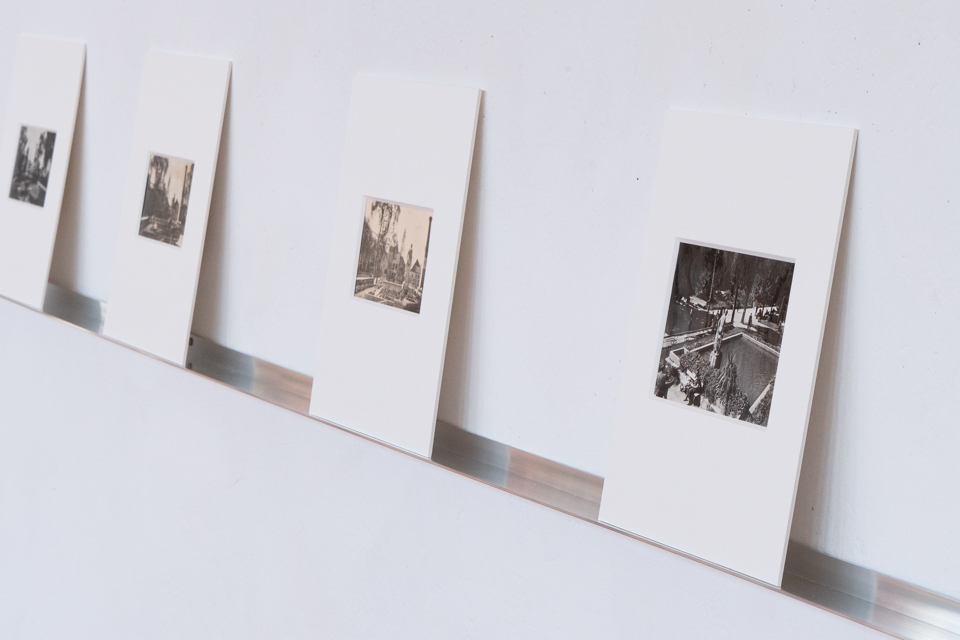The Girl Without Qualities
Jiří Havlíček
21.06. – 22.07.18
As part of this year’s program, focusing on young art teachers at university level, the Entrance Gallery will introduce Jiří Havlíček. Together with Filip Nerad, he teaches at the Faculty of Arts, the ‘Text, Form and Function’ Atelier in Ostrava. This is however just one of Havlíček’s many activities. Apart from that, he is active as a curator, cameraman, and writer.
His installation for the Entrance Gallery combines Havlíček’s zest for motion picture, or verbally spoken a decomposition of the film medium and the process of imaging, and, by extension, of vision itself. He deconstructs and pulls together again the image taken by the camera, as if trying to feel the object under investigation by means of the camera eye. The minimalist installation at the Entrance Gallery is an object in itself and telling the object’s story at the same time. It tells the tale of a statue of a naked woman, which comes to life at the exhibition opening, embodied by dancer Tereza Hradilková, choreographed by Hana Polanská Turečková.
The focus of Havlíček’s interest is the statue by Josef Jiříkovský from 1929 at the open-air swimming pool in Bohdaneč Spa, depicting a young girl before entering the water. As the simple authoritative model of vision represented by camera obscura was already disrupted with the onset of physiology, the same way it appears in Havlíček’s thinking like a fact that none of the objects can really be expressed by a two-dimensional medium, less so in a veritable way. Already in the early 19th century, Goethe’s Color Theory started a revolution in apprehending the seen, and presented a model of subjective vision, which can be achieved through the body, a body respecting its physiological features and abilities, its carnality. Thus an image is presented to us, of a new, “productive” observer. For the first time, a visual experience is admitted, which necessarily does not refer to the reality outside the observing subject. Neither Jiří Havlíček tries to present the statue, which became the focal point of his exhibition and mainly of the author’s interest, in a “veritable” way. His records and ways of showing the statue to us consist in touching and feeling it, and pointing to the diversity of possibilities the final image might have, rather than striving for a perfect description. As if the artist tried to materialize the image seen by that subjective observer. Yet even that cannot be universal. So it remains as fleeting as the performance staged at the exhibition opening. It complements the installation of one projection screen and 24 black-and-white postcards, capturing Jiříkovský’s statue from different angles, as if its author tried to circumvent it totally.
Havlíček quite obstinately tries to show us something he himself believes is not possible. The point is not a “mere” depiction of three dimensions by means of two with the aim to prove the already proven. In his video, which is the combination or compilation of a digitalized 16 mm film and 3D modeling, Jiříkovský lets his lifeless sculpture show signs of mental activity. He himself calls it a “petrified, intoxicated monologue”. It is this layer of the whole project that moves the story of a statue in one place a little further than where the story would stop of an impossible depiction and physiological perception of the new viewer, described by Jonathan Crary1 and just now disrupting the simple model of camera obscura imagery, as it is not just one eye but two eyes, which are looking. Havlíček’s “intoxicated monologue” refers us to further discovering more attributes of the naked woman. A woman who in her nakedness is exposed to unsolicited looks of the public, as if she declared her attitude to life by passively accepting all that happens around her. Similar to Musil’s Man Without Qualities, whose first volume was published in Germany just one year after Jiříkovský’s statue was finished. In his installation Havlíček shows us not only basic descriptive qualities of the mysterious woman, but opens a game with us about her possible further features, which she may feel indifferent about, the same as Ulrich, whose description “is not difficult to give (…), in general outline, even though all he knew about himself was that he was as far from all the qualities as he was near to them, and that all of them, whether they had become his own or not, in some strange way were equally a matter of indifference to him.” 2
Comments:
1 – In the 19th century an important change occurs in the perception of the observer, i.e. in the way vision in general is being formed. Jonathan Crary deals with this “modernizing vision” in his study of the same name. Unlike traditional understanding of the relationship between the world and an individual, Crary’s individual is creative or active also on the physiological, i.e. bodily, level. Vision ceases to be just a simple, automated activity designed to employ its basic cognitive function to render reality in the most veritable way.
2 – Robert Musil (1930): The Man Without Qualities, Vol. 1, p.126
Text Tereza Velíková
The exhibition was supported within the grant competition of the projects of the specific academic research of AVU.
Special thanks to: Martina Holá, Tereza Hradilková, Hana Polanská Turečková, Peter Demek, Matěj Doležel, Vilém Duha, Filip Nerad, Petr Strouhal, Lukáš Zálešák, Galerie Polansky.
Entrance Gallery is supported by Municipal District of Prague 6, Ministry of Culture Czech Republic, Prague City Hall and Foundation for Contemporary Arts Prague and GESTOR – The Union for the Protection of Authorship.






